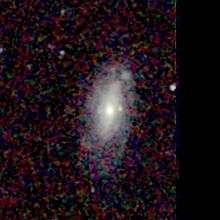NGC 7448
NGC 7448 is a spiral galaxy located in the constellation Pegasus. It is located at a distance of circa 80 million light years from Earth, which, given its apparent dimensions, means that NGC 7448 is about 60,000 light years across. It was discovered by William Herschel on October 16, 1784.[2] It is included in the Atlas of Peculiar Galaxies in the category galaxies with detached segments.
| NGC 7448 | |
|---|---|
 NGC 7448 (SDSS DR14) | |
| Observation data | |
| Constellation | Pegasus |
| Right ascension | 23h 00m 03.6s[1] |
| Declination | +15° 58′ 49″[1] |
| Redshift | 0.007318 ± 0.000003 [1] |
| Helio radial velocity | 2194 ± 1 km/s[1] |
| Distance | 79.5 ± 22.9 Mly (24.4 ± 7.0 Mpc)[1] |
| Apparent magnitude (V) | 11.4 |
| Characteristics | |
| Type | SA(rs)bc [1] |
| Apparent size (V) | 2′.7 × 1′.2[1] |
| Other designations | |
| UGC 12294, Arp 13, MCG +03-58-018, PGC 70213[1] | |
NGC 7448 features an inner disk region of tightly wound spiral fragments with high surface brightness. At the edge of this region the surface brightness decreases abruptly. At the outer part of the disk individual arm segments and dust lanes can be discerned. The outer arms feature HII regions.[3] One HII region complex located at the northwest portion of the disk is as bright as the bulge.[4] Two supernovae have been observed in NGC 7448, SN 1980L (mag 13.5), and SN 1997dt (type Ia, mag 15.3).[5]
NGC 7448 belongs to a galaxy group known as the NGC 7448 group. Other members of the group are the galaxies NGC 7437, NGC 7454, NGC 7463, NGC 7464, and NGC 7465.[6] The last three form a compact subgroup and there is evidence that NGC 7464 and NGC 7465 are in the process of merging. NGC 7479 lies a bit further to the south, and may be part of the group. There is a tail of HI gas extening from NGC 7448 and a stream of gas extending from NGC 7464/65 to NGC 7448.[7]

References
- "NASA/IPAC Extragalactic Database". Results for NGC 7448. Retrieved 2016-01-18.
- Seligman, Courtney. "NGC 7448 (= Arp 13 = PGC 70213)". Celestial Atlas. Retrieved 19 November 2018.
- Sandage, A., Bedke, J. (1994), The Carnegie Atlas of Galaxies. Volume I, Carnegie Institution of Washington
- Takase, B. and Miyauchi-Isobe, N. (1985). "Kiso Survey for Ultraviolet-excess Galaxies. II". Annals of the Tokyo Ast. Obs. 20 (237–281).CS1 maint: multiple names: authors list (link)
- List of Supernovae IAU Central Bureau for Astronomical Telegrams. Retrieved 29 December 2015.
- Makarov, Dmitry; Karachentsev, Igor (21 April 2011). "Galaxy groups and clouds in the local (z∼ 0.01) Universe". Monthly Notices of the Royal Astronomical Society. 412 (4): 2498–2520. arXiv:1011.6277. Bibcode:2011MNRAS.412.2498M. doi:10.1111/j.1365-2966.2010.18071.x.
- Davies, J. I.; Auld, R.; Burns, L.; Minchin, R.; Momjian, E.; Schneider, S.; Smith, M.; Taylor, R.; van Driel, W. (1 August 2011). "The Arecibo Galaxy Environment Survey - IV. The NGC 7448 region and the HI mass function". Monthly Notices of the Royal Astronomical Society. 415 (2): 1883–1894. Bibcode:2011MNRAS.415.1883D. doi:10.1111/j.1365-2966.2011.18833.x.
External links
| Wikimedia Commons has media related to NGC 7448. |
- NGC 7448 on WikiSky: DSS2, SDSS, GALEX, IRAS, Hydrogen α, X-Ray, Astrophoto, Sky Map, Articles and images